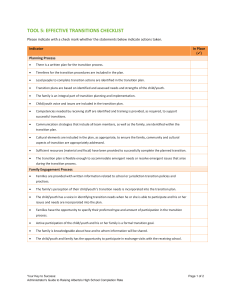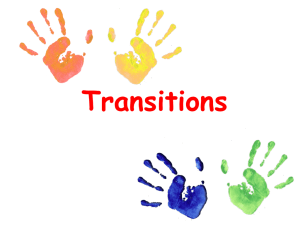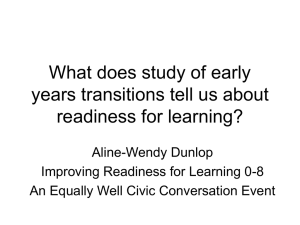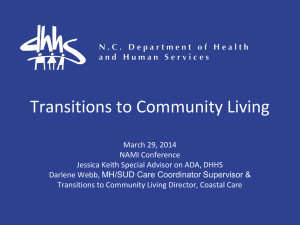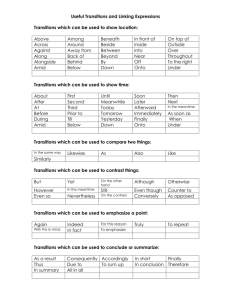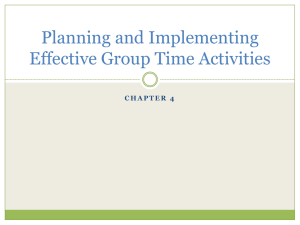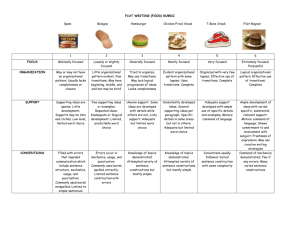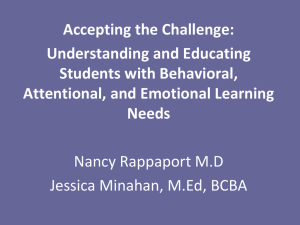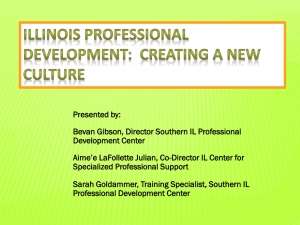The Wonderful World of Transitioning: Home to Center
advertisement
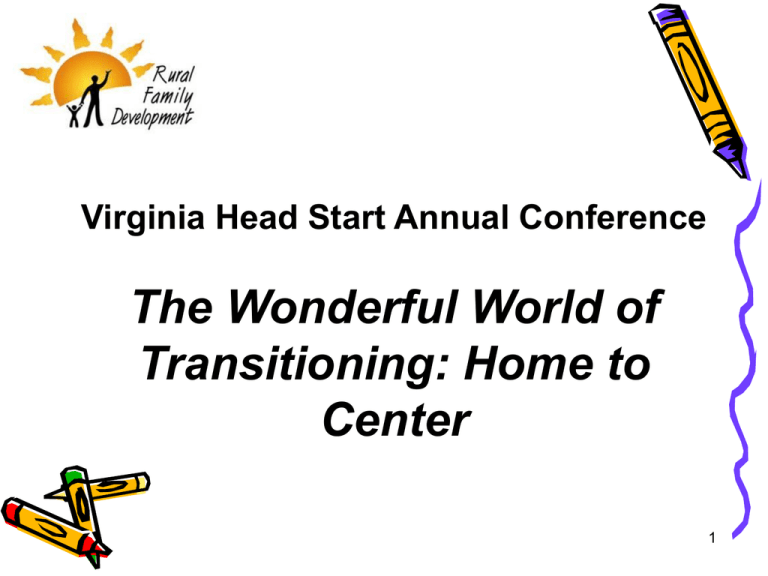
Virginia Head Start Annual Conference The Wonderful World of Transitioning: Home to Center 1 INTRODUCTION &AGENDA LaNeen Sample Education Services Specialist Stephanie Turner Classroom Support Coordinator Introduction and Warm-up 2 What does transitioning really mean? Linking schools, families, child care providers, early childhood educators and community based partners in support successful transitions of children into Early Head Start, Early Head Start and public schools. 3 Assessing the Needs • Very few schools/Head Starts have transition plans linking home to Head Start/school • Many families don’t feel connected to the school or program prior to the child’s entry. 4 Outcomes from Assessing Parental School Readiness Needs – Parents didn’t know what will be expected of their children – Child care providers varied widely in their understanding of Head Start/School expectations – Schools were not in contact with child care/Head Start providers or parents prior to kindergarten registration – Head Start and Early Head Start Programs offered limited information about Head Start Programming that they provided 5 6 Critical Action • Attention to community needs – Parent involvement with the Head Start/school; improves academic success – Building relationships with parents and teachers is key to smooth home to school transitions 7 Key Goals & Objectives Goal: To improve school readiness and support successful transition of children and their families is to: • Objectives: 1. Fostering communication, building relationships among families, caregivers Head Start and schools that promote successful transitions 8 Key Goals & Objectives 2. Working to align-or match up-children’s learning and development experiences among home, early education and child care and school to boost children’s confidence and learning 3. Implementing strategies to enhance early literacy and reduce nonacademic barriers to early learning (e.g. language and interpretation/translation for families most at risk 9 School Transition Team Structure • Neighborhood representation: the one school leader representative (principal or assistant principal) in addition to a kindergarten teacher (stipend provided) from one of the elementary schools – Two early care/education teachers/providers from Head Start or Early Head Start 10 School Transition Team Structure – Two parent “community ambassadors’ representing communities whose children are getting left behind, who will both participate in the Team and serve as a liaison to their community – Four representatives from community organizations (public library, family support services, faith-based groups, etc.) and/or informal community leaders 11 Getting School Ready Neighborhood School Transition Team Results • GSR Teams developed a “Getting School Ready Connections” is an outreach model that documents effective ways to reach and communicate with the community’s families, licensed and informal caregivers, community agencies and teachers. 12 13 Children with Special Needs Home-School Transition Case Study • How might we plan for home to school transitions for children with unique and special needs? • How would you partner with parents? • What would you learn from parents? • Who needs to be involved? • Who Needs to be informed? 14 What We Can Do! 1. Acknowledge the information gap between schools, families, and childcare providers. 2. Increased outreach to families of young children 3. Provide early learning activities for families and childcare providers before services begin 4. Receive insight into incoming student demographics and skill level. 15 16 What We Can Do! • Increased parent’s understanding of early learning and school readiness. • Provide a parent/ family friendly connection with school and teachers. • Support parents obtaining simple, everyday ways to promote early childhood literacy and help prepare their child for Head Start/school. 17 18 How Do We Do This? • Training and technical assistance. • Collaboration and joint training with schools and Head Starts • Collaboration local Interagency Coordinating Councils • Anyone interested in early learning and development 19 INTERACTIVE ACTIVITIES Infants Activities • Activity: Where is the Sound? • Materials: Toys/objects that make different sounds • Objective: This activity will help baby develop auditory tracking skills and develop head and neck control. • Activity: Handy Clap • Materials: Baby in sitting or lying position • Objective: This activity will help the baby develop eye/hand coordination while increasing a sense of trust and attachment. 20 Toddlers Activities • Activity: Color Sorting • Materials: Colored Blocks/Cubes, Large Legos • Objective: This activity will help children learn about matching and sorting colors while engaging in positive social interaction. • Activity: Building It • Materials: Building Blocks, Large Lego Blocks • Objective: This activity will help young children learn cooperative play and help them develop compassion, or understanding of how others feel. 21 Preschool Activities • Activity: Color, Sizes and Shapes Activities and Games • Materials: Assorted Shapes and Games • Objective: This activity will help young children with recognition of color, shape, size and Language Development. • Activity: Number and Counting Activity • Materials: Assorted Items • Objective: This activity will help the young children with creative number usage. 22 Thank You! LaNeen Sample Education Services Specialist Stephanie Turner Classroom Support Coordinator 23
